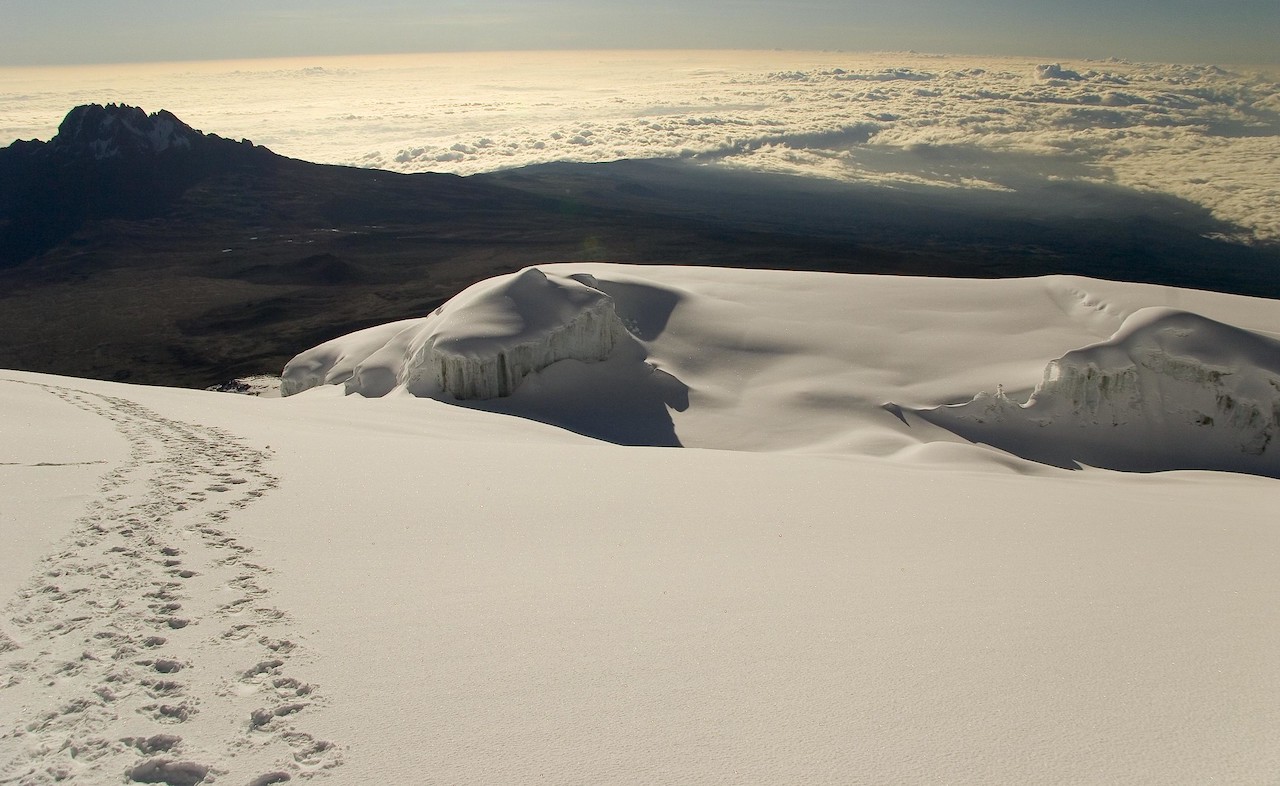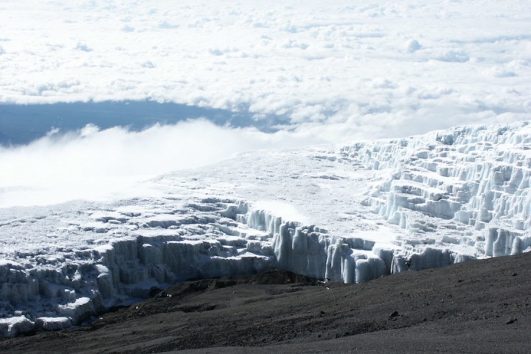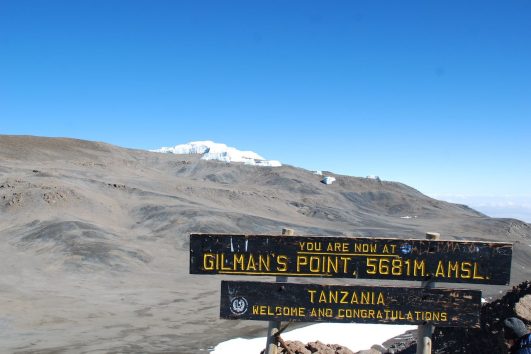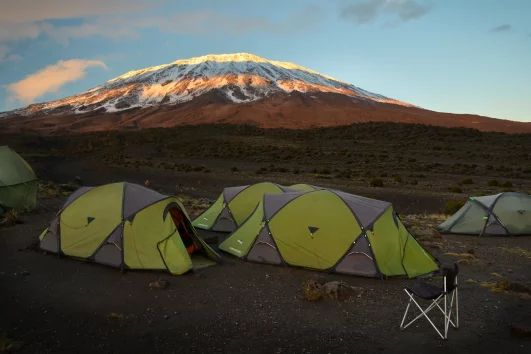Northern Ice Field – Kilimanjaro’s Icy Crown
Elevation: 5,800 meters (19,000 feet)
Perched high atop Mount Kilimanjaro, the Northern Ice Field is one of the last remaining vestiges of the once-mighty glaciers that adorned Africa’s tallest peak. This vast sheet of ice, located just below Kilimanjaro’s summit at an elevation of approximately 5,800 meters (19,000 feet), offers trekkers a glimpse of the mountain’s ancient, glacial past. Despite its shrinking size due to climate change, the Northern Ice Field remains a striking feature of Kilimanjaro’s summit area, offering a stark contrast to the barren volcanic slopes and the equatorial sky surrounding it.
The ice field, positioned on the northern slopes of Kibo, one of Kilimanjaro’s volcanic cones, covers several square kilometers and is closely linked to other famous glaciers like the Furtwängler Glacier. For climbers approaching via the Northern Circuit Route, the Northern Ice Field is an awe-inspiring sight, a rare phenomenon for a mountain located so close to the equator. Unfortunately, like many glaciers around the world, this ice field is receding at an alarming rate, leading experts to predict that it could disappear entirely within the next few decades.
The Geological and Historical Significance of the Northern Ice Field
The Northern Ice Field, along with Kilimanjaro’s other glaciers, has been a subject of fascination for scientists, adventurers, and environmentalists alike. Formed thousands of years ago, the ice field is a remnant of a much larger ice cap that once covered the summit. This icy plateau is a window into Kilimanjaro’s glacial history, offering valuable insights into the mountain’s past climate and geological development.
The ice field’s slow yet dramatic retreat is a poignant reminder of the impact of global climate change. Over the past century, Kilimanjaro’s glaciers have significantly receded, and the Northern Ice Field is no exception. Satellite imagery and on-site measurements show that it has lost more than half of its volume, with the ice thinning and retreating towards the summit. If current trends continue, it is likely that Kilimanjaro’s glaciers, including the Northern Ice Field, will vanish altogether by 2040.
Despite this, the Northern Ice Field remains one of Kilimanjaro’s most iconic features, offering climbers a surreal landscape at the roof of Africa. The contrast between the ice and the surrounding volcanic terrain is otherworldly, creating a visual spectacle that few places on Earth can match.
The Trek to the Northern Ice Field
While many climbers take the traditional routes up Mount Kilimanjaro, such as the Marangu or Machame Routes, the Northern Circuit Route provides the best views of the Northern Ice Field. This lesser-traveled path circumnavigates the entire northern side of Kilimanjaro, allowing trekkers to get up close to this remarkable ice field while enjoying unparalleled solitude and sweeping vistas.
Reaching the Northern Ice Field requires a multi-day ascent, with climbers passing through a variety of ecological zones, from lush rainforests to alpine deserts, before reaching the arctic-like summit zone. The approach to the ice field itself is steep and demanding, but the reward is a breathtaking panorama of icy cliffs, shimmering glaciers, and the expansive Tanzanian landscape far below.
As trekkers near the Uhuru Peak, Kilimanjaro’s highest point, the Northern Ice Field becomes visible in all its glory, a stark white expanse of ice against the dark volcanic rock. The air is thin, and the cold is biting, but standing beside this ancient glacier is an experience that few will ever forget.
Climate Change and the Future of the Northern Ice Field
The Northern Ice Field’s rapid retreat is a profound indicator of global climate change. Studies conducted by scientists have shown that Kilimanjaro’s glaciers, including the Northern Ice Field, have been retreating at an accelerating pace since the early 20th century. While seasonal weather patterns and regional climate variations play a role, the long-term trends suggest that rising global temperatures are the primary driver of the ice loss.
In addition to its symbolic significance as a “tropical glacier,” the Northern Ice Field is a valuable source of scientific data. Researchers have drilled ice cores from the glacier, which reveal centuries of climatic history, offering clues about past atmospheric conditions, volcanic eruptions, and changes in the Earth’s environment.
As the Northern Ice Field continues to shrink, there is growing urgency to preserve its legacy through scientific study and by raising awareness of the broader impacts of climate change. For trekkers who visit Kilimanjaro, witnessing the ice field firsthand serves as a powerful reminder of the fragile beauty of our planet’s natural wonders.
The Awe-Inspiring Beauty of the Northern Ice Field
For those fortunate enough to stand near the Northern Ice Field, the experience is nothing short of magical. As the sun rises over the horizon, casting golden light on the glaciers, the entire landscape seems to glow with an ethereal beauty. The interplay of light and shadow on the ice creates a dazzling spectacle, with the peaks and ridges of the ice field reflecting the sun’s rays in brilliant hues of blue and white.
Trekkers often pause here to absorb the majesty of the scene, take photographs, and reflect on the incredible journey that has brought them to this point. The ice field, though diminished, still holds a mystique that captivates the imagination. Whether viewed from afar or up close, the Northern Ice Field is a reminder of the sheer power and grandeur of nature.
Quick Facts About the Northern Ice Field
Location: Near the summit of Kibo on Mount Kilimanjaro.
Elevation: Approximately 5,800 meters (19,000 feet).
Routes: Best viewed from the Northern Circuit Route.
Formation: A remnant of Kilimanjaro’s once-extensive ice cap.
Size: Shrinking rapidly due to climate change.
Estimated Disappearance: Predicted to vanish by 2040 if current trends continue.
Scientific Importance: Ice cores from the Northern Ice Field provide valuable data on past climate conditions.
Read also about the Arrow Glaciers on Mount Kilimanjaro which is normally covered by snow during colder months.
FAQs About the Northern Ice Field
-
Can you hike across the Northern Ice Field?
Answer: While climbers do not typically hike across the ice field itself, they pass near it, especially on the Northern Circuit Route, where they can view it up close.
-
Is the Northern Ice Field still growing or shrinking?
Answer: The Northern Ice Field is shrinking rapidly due to global climate change and may disappear entirely by 2040 if current trends continue.
-
What is the best route to see the Northern Ice Field?
Answer: The Northern Circuit Route offers the best views of the Northern Ice Field, with a more gradual ascent and fewer crowds.
-
How long does it take to reach the Northern Ice Field?
Answer: Reaching the vicinity of the Northern Ice Field typically takes several days of trekking, depending on the route chosen. The Northern Circuit Route takes around 9 to 10 days to complete.
-
Is the Northern Ice Field visible from Uhuru Peak?
Answer: Yes, climbers can see the Northern Ice Field from near the summit of Kilimanjaro, particularly when approaching from the northern side.
-
Can the Northern Ice Field be restored?
Answer: Unfortunately, once glaciers like the Northern Ice Field recede, they cannot be easily restored. Their decline is largely irreversible due to climate change.
-
How cold is it near the Northern Ice Field?
Answer: Temperatures near the Northern Ice Field can drop well below freezing, especially at night, so proper cold-weather gear is essential for climbers.
-
What makes the Northern Ice Field special?
Answer: Its unique location near the equator, combined with its status as one of the few remaining tropical glaciers, makes the Northern Ice Field a geological and environmental wonder.





Tour Reviews
There are no reviews yet.
Leave a Review